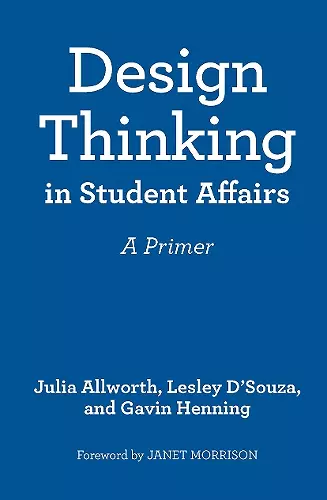Design Thinking in Student Affairs
A Primer
Gavin W Henning author Julia Allworth author Lesley D'Souza author
Format:Hardback
Publisher:Taylor & Francis Inc
Published:4th Oct '21
Currently unavailable, and unfortunately no date known when it will be back
This hardback is available in another edition too:
- Paperback£32.99(9781642670332)

Design thinking is an innovative problem-solving framework. This introduction is the first book to apply its methodology to student affairs and, in doing so, points the way to its potentially wider value to higher education as a whole.With its focus on empathy, which is the need to thoroughly understand users’ experiences, design thinking is user-centered, similar to how student affairs is student-centered. Because the focus of design thinking is to design with users, not for users, it aligns well with student affairs practice. In addition, its focus on empathy makes design thinking a more equitable approach to problem-solving than other methods because all users’ experiences—not just the experiences of majority or “average” student—need to be understood. Centering empathy in problem-solving processes can be a tool to disrupt higher education systems and practices.Design thinking is a framework to foster innovation, and, by its nature, innovation is about responding to change factors with creativity. In an organization, design thinking is inherently connected to organizational change and culture because the process is really about changing people to help them rally around a disruptive idea. Implementing design thinking on a campus may in itself be disruptive and require a change management process. The beauty of using design thinking is that it can also act as a framework to support organizational culture change.Design thinking approaches, with their focus on stakeholder needs (as opposed to systemic norms), collaborative solutions building, and structured empathy activities can offer a concrete tool to disrupt harmful systems of power and oppression. Design thinking as a process is not a magic solution to equity problems, though it can be a powerful tool to approach the development of solutions that can address inequity. Design thinking is data-driven and considers both qualitative and quantitative data as necessary to gain most complete picture of an issue and its possible solutions, whether a product, program, or service.Design thinking has numerous benefits to afford students affairs. Chapter 1 outlines a case for design thinking in student affairs. Chapter 2 discusses a brief history of design thinking, noting its germination and evolution to current practice. Chapter 3 provides a detailed description of each step of the design thinking model with pertinent examples to make the steps clearer. Chapter 4 explains the intersection...
"This book presents a reimagined model of assessment with design thinking, and instantly upon seeing it, you know how needed it is in education today. Focusing upon empathy, ideation, and storytelling throughout the assessment process, the authors of this book present a human-centered approach to engage in assessment of student learning. The design thinking assessment model and key questions remind us that our works sits within a larger context, one that can be infused with equity and act as a tool for decolonizing education."
Natasha Jankowski
Former Executive Director of the National Institute for Learning Outcomes Assessment
"Design thinking can move organizations forward and find innovative solutions. This book in particular applies design thinking to student affairs and is a fantastic resource." Find Drew's full video review here.
Drew Koch
Student Services Coordinator, R. Ken Coit College of Pharmacy, University of Arizona
ISBN: 9781642670325
Dimensions: unknown
Weight: 385g
250 pages